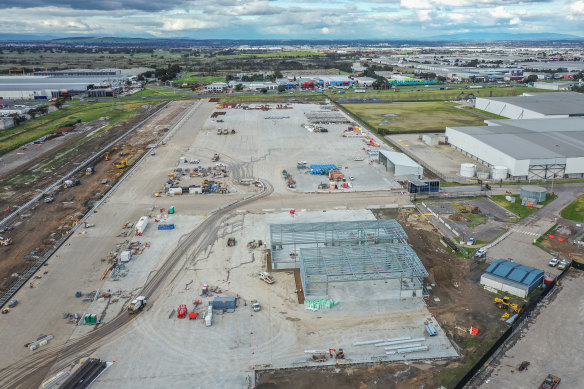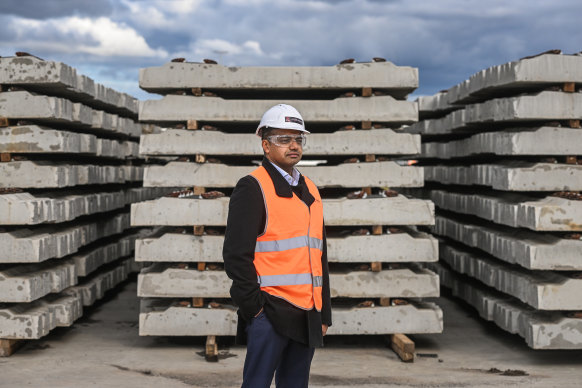A $400 million freight hub in Melbourne’s outer north will be so large that the Commonwealth doesn’t need to spend $1.6 billion on its own facility 20 kilometres away, owners of the new rail terminal say.
The Somerton Intermodal Terminal, which is aimed at reviving rail freight and get trucks off the road, is due to open late next year at the Austrak Business Park, 21 kilometres north of the CBD. The terminal will make it possible to move imports from the Port of Melbourne to one of the city’s key industrial zones by train rather than truck.

The Somerton Intermodal Terminal is set to open late next year. Credit: Justin McManus
The Intermodal Terminal Company (ITC) – which is owned by Aware Super, the country’s third-largest superannuation fund – says the terminal could remove 500,000 truck trips from inner-Melbourne roads and interstate highways a year, or about 1300 a day.
“The inner streets of Melbourne are getting more and more congested as the freight task continues to grow, and those potholes that we see in our roads are a result of heavy trucks,” ITC chief executive Mishkel Maharaj said.
“So rail freight is better for the community – it’s [about] carbon emissions, road safety, road damage and congestion.”
Only about 6 per cent of containers move in and out of the Port of Melbourne by rail, a figure which has fallen by half since 2011. Only 2 per cent of freight between Melbourne and Sydney travels by rail.
Rail freight produces 16 times less carbon pollution than road freight. Reviving its share of the country’s freight load is a priority for the federal and state governments. The $31 billion Inland Rail project is intended to make rail journeys between Melbourne, Sydney and Brisbane faster, more reliable and cheaper.

Intermodal Terminal Company CEO Mishkel Maharaj says building both projects is like “like building two airports down the road from each other”. Credit: Justin McManus
Maharaj said existing rail connections at the 45-hectare Somerton terminal meant on-site tenants such as Coles and Bunnings and nearby warehouses could receive goods from the port, repack them and then distribute them interstate all on rail.
Modelling the ITC commissioned from Deloitte suggests Somerton’s capacity to handle the equivalent of 1 million 20-foot [six-metre] containers when it first opens, with the potential to double that with expansions, would be sufficient to manage all interstate freight until the mid-2050s.
Maharaj said that showed it was not necessary for the Commonwealth to spend over $1.6 billion building another intermodal terminal 20 kilometres further north at Beveridge.
“The capacity is here. We’re not asking the taxpayer to put their hand in their pocket, because an industry super fund is,” he said. “Otherwise, you’re duplicating infrastructure – it’s like building two airports down the road from each other.”
The Morrison government committed $1.6 billion for the Beveridge Interstate Freight Terminal and $280 million for associated road connections in the 2022-23 budget, which it hoped would help it win the marginal seat of McEwen.
The state Labor government had since 2018 been pushing for a terminal at Truganina, in Melbourne’s west. However, in May, the Allan government said it would defer plans for the Western Interstate Freight Terminal “until when it’s needed” and backed proceeding with the Beveridge development.
A Victorian government spokesperson said the state welcomed private sector and industry proposals to handle growing freight volumes.
“We’ll continue working with the Commonwealth, local government and industry as work progresses to establish intermodal terminals and to deliver inland rail.”
National Intermodal CEO James Baulderstone said the Somerton terminal would be complementary to the facility the Commonwealth-owned enterprise was planing for Beveridge, which had up to 600 hectares available for warehouse development.
“It’s a precinct rather than an intermodal terminal,” he said. “If you want a lower cost for rail versus road, it’s in that last mile of pick-up and delivery. So to solve that … you need the customer to be co-located.”
Baulderstone also warned that there was a risk private terminal operators would capture the value delivered by the Inland Rail Project rather than it being passed on to consumers in the form of cheaper products.
Baulderstone said National Intermodal intended to open an initial terminal at Beveridge by 2026 and a main terminal by 2028, which would have capacity for half-a-million container equivalent units a year.
The volume of freight through the Port of Melbourne, which is already Australia’s busiest port, is projected to grow from about 3 million container equivalent units a year to 4 million by 2032 and to 5 million by 2040.
The Port of Melbourne’s head of intermodal, Charles Cornish, said the port was pleased to see the Somerton terminal progress as part of its efforts to build a network that could move freight away from the port for processing at industrial hubs in the outer city.
“We are keen to see freight shift from road to rail, delivering productivity and environmental benefits,” he said.
Start the day with a summary of the day’s most important and interesting stories, analysis and insights. Sign up for our Morning Edition newsletter.